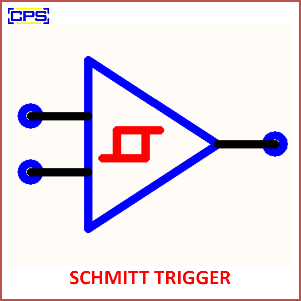A Schmitt Trigger is an electronic circuit that converts an analog input signal into a digital output signal, introducing hysteresis to reduce sensitivity to noise or small fluctuations in the input. It is commonly implemented using operational amplifiers (op-amps) or comparators. The circuit is characterized by having two distinct threshold voltage levels: the upper threshold voltage (UTP) and the lower threshold voltage (LTP).

Key Features of a Schmitt Trigger
- Hysteresis:
- The input signal must cross two different thresholds to change the output state, preventing false triggering due to noise or small variations in the input signal.
- Digital Output:
- Produces a clean, rectangular waveform at the output even when the input signal is noisy or slowly varying.
- Nonlinear Operation:
- The input-output relationship is nonlinear, making it ideal for waveform shaping.
Working Principle:
- When the input voltage exceeds the upper threshold (UTP), the output switches to one state (e.g., high).
- When the input voltage falls below the lower threshold (LTP), the output switches to the opposite state (e.g., low).
- Between these two thresholds, the output remains unchanged, creating the hysteresis effect.
Applications of Schmitt Trigger:
- Signal Conditioning:
- Used to convert noisy analog signals into clean digital signals.
- Waveform Shaping:
- Shapes non-ideal waveforms, such as sine waves or triangular waves, into square waves.
- Oscillator Circuits:
- Forms the basis of relaxation oscillators to generate periodic waveforms.
- Debouncing:
- Eliminates bouncing effects in mechanical switches and pushbuttons.
- Noise Immunity:
- Ensures reliable operation in environments with high electrical noise.
Advantages:
- High noise immunity due to hysteresis.
- Eliminates false triggering caused by slow or noisy input signals.
- Simple and cost-effective implementation.
Disadvantages:
- May introduce a delay or lag due to hysteresis, which could be undesirable in certain fast-switching applications.
- Not suitable for precision threshold detection where hysteresis is not desired.
